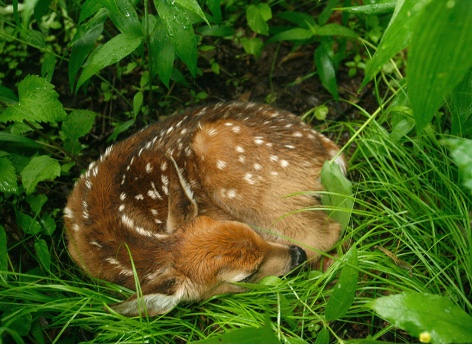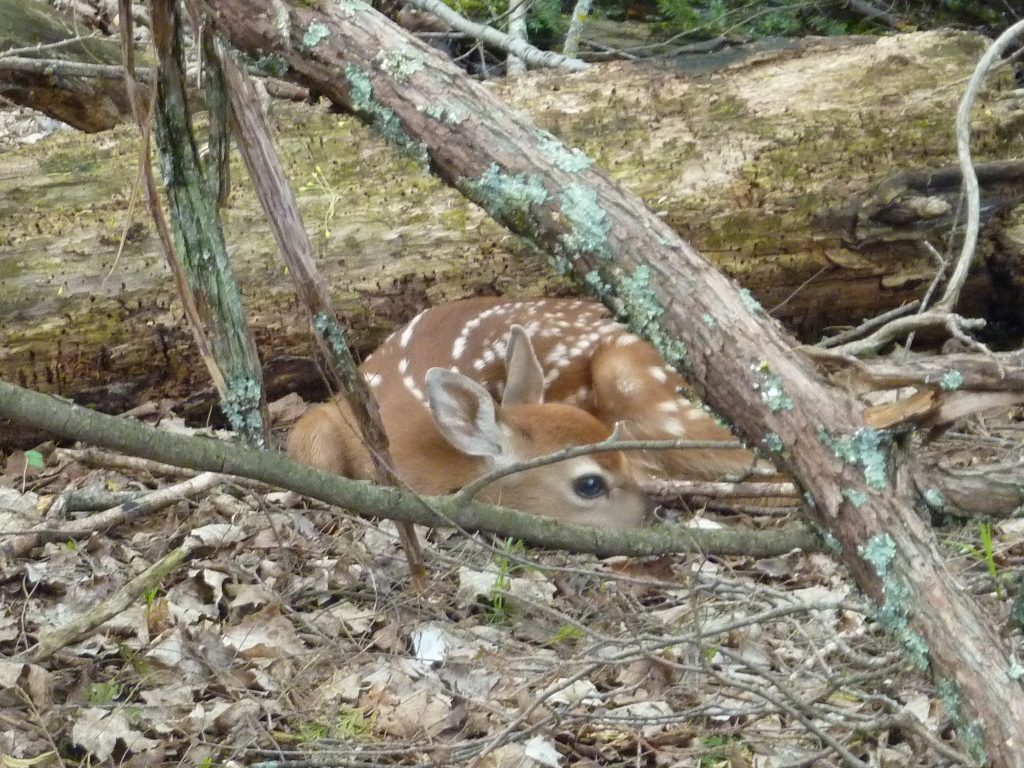How Do You Tell What Sex a New Baby Deer Is
deer environmental
Reproduction

Photograph: Chris Immature
Breeding season (rut)
October–January
Breeding system
Polygamous—One male mates with several females during the breeding season. Salubrious males may mate with half dozen to 8 females.
Litters
1 litter per year with 1 to 3 fawns, simply usually 2.
Kickoff-time mothers unremarkably requite nascence to just ane fawn.
Sex ratio—The number of males to females depends on multiple factors. In deer, the sex ratio tin can vary from ane:one.
Nascence expanse
Females tend to give birth in grassy areas virtually woods, usually isolated from other deer. They oft use the same fawning areas they used in previous years.
Maturity
Females attain sexual maturity the aforementioned year they are born. Males attain maturity the 2nd convenance flavor later nascence, or at nearly 18 months.
Gestation flow
200 to 210 days
Time of birth
April–July, but about often May–June
Fawns

Photograph: Chris Young
- Fawns weigh four to 7 pounds at birth and tin stand and run slowly within a few hours.
- For the outset weeks of life, fawns avert predation past remaining motionless in areas of cover.
- A fawn's spotted glaze provides camouflage in the cleaved patterns of sunlight reaching the woodland floor.
- Fawns are often left alone. If you find a fawn, go out it where you found it. Many "rescued" fawns that people idea were orphans were not actually orphaned.
Care of immature
The female raises the fawn. A female person deer will typically flee when a human or predator approaches their fawn. They may or may non make alarm sounds.
Weaning
About 5 weeks of age
More Well-nigh Fawns

Photograph: Jared Duquette
Fawns in the first week afterwards nascence exhibit alarm bradycardia (the middle rate decreases chop-chop to aid in the "freezing" response) to avoid detection by predators. They besides are virtually scentless after nascency to help them avoid predators, but they gain scent as they historic period.
Activeness of fawns during the first week of life consists of nursing and moving between bedding sites, which accounts for only 3% of their fourth dimension. They sleep and rest the residual of the time. By 9 weeks of age, fawns are active 27% of the mean solar day.
The fawn and mother brand sounds and use the sense of smell to aid locate each other. If the fawn is threatened, the female person snorts and stamps her front feet and may charge the predator to bulldoze it away. As the fawn grows and gets stronger, it begins following the female person equally she forages.
Fawns nurse an boilerplate of twice daily. As the fawns age, the time spent nursing increases, but the frequency does not.
Fawns must have microorganisms in their rumen to pause down the vegetative matter they consume. For their first month they live exclusively on milk. Afterward a month or and so, fawns brainstorm to swallow grasses, tender woody vegetation, and even shelled corn. At times, the female will drive a fawn away that still wants to suckle after attaining the historic period of v to 6 months.
Small fawns are unafraid of humans. Until they are 4 or 5 days onetime, they volition not attempt to escape when detected. It is at this stage that most deer fawns are taken alive illegally because they are mistaken for orphans. Sometimes, fawns end up in strange places, such as on sunny porch steps. If you notice a fawn by itself, do not motion it. The mother is unremarkably nearby, though not necessarily in sight. She will render to the fawn twice a day so that it can nurse.
due north ane Illinois study, 121 females produced 221 fawns (102 females, 119 males) that survived to at to the lowest degree one year sometime. Among these 221 fawns, 35 (29%) nascency events produced single fawns, 78 (63%) produced twins, and 10 (8%) produced triplets. It is possible for a meaning doe to have iv or five fawns, but it is very uncommon.

Photo: Robert J. Reber
For midwestern states, the percentage of fawns that became pregnant ranged from 2% (Minnesota) to 29% (Iowa to Nebraska). For yearlings, the range was 55% (Iowa to Nebraska) to 88% (Minnesota). For adults, the pregnancy rates varied from 71% to 96% (multiple states). Contrary to what was in one case believed, females never accomplish senescence; they reproduce until they die.
Interestingly, a study of deer in westward-central, northern, and e-primal Illinois found that dominant females of any age produced more female person offspring. Of fawns born to younger dominant females, 72% were female person; to fawns born to older dominant or subordinate female person breeders of whatever age, only l% were female.
Source: https://deer.wildlifeillinois.org/deer-ecology/reproduction/
0 Response to "How Do You Tell What Sex a New Baby Deer Is"
Post a Comment